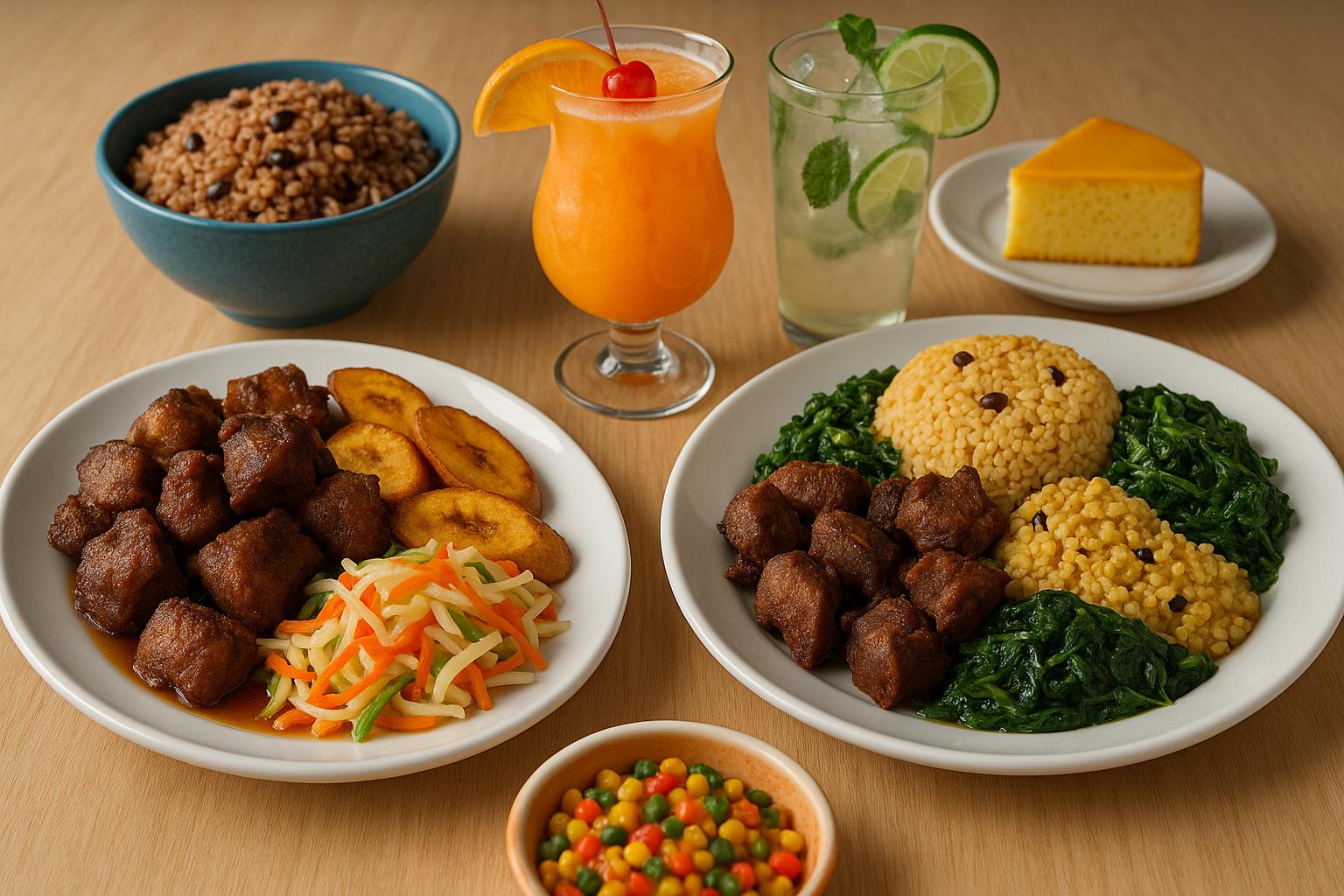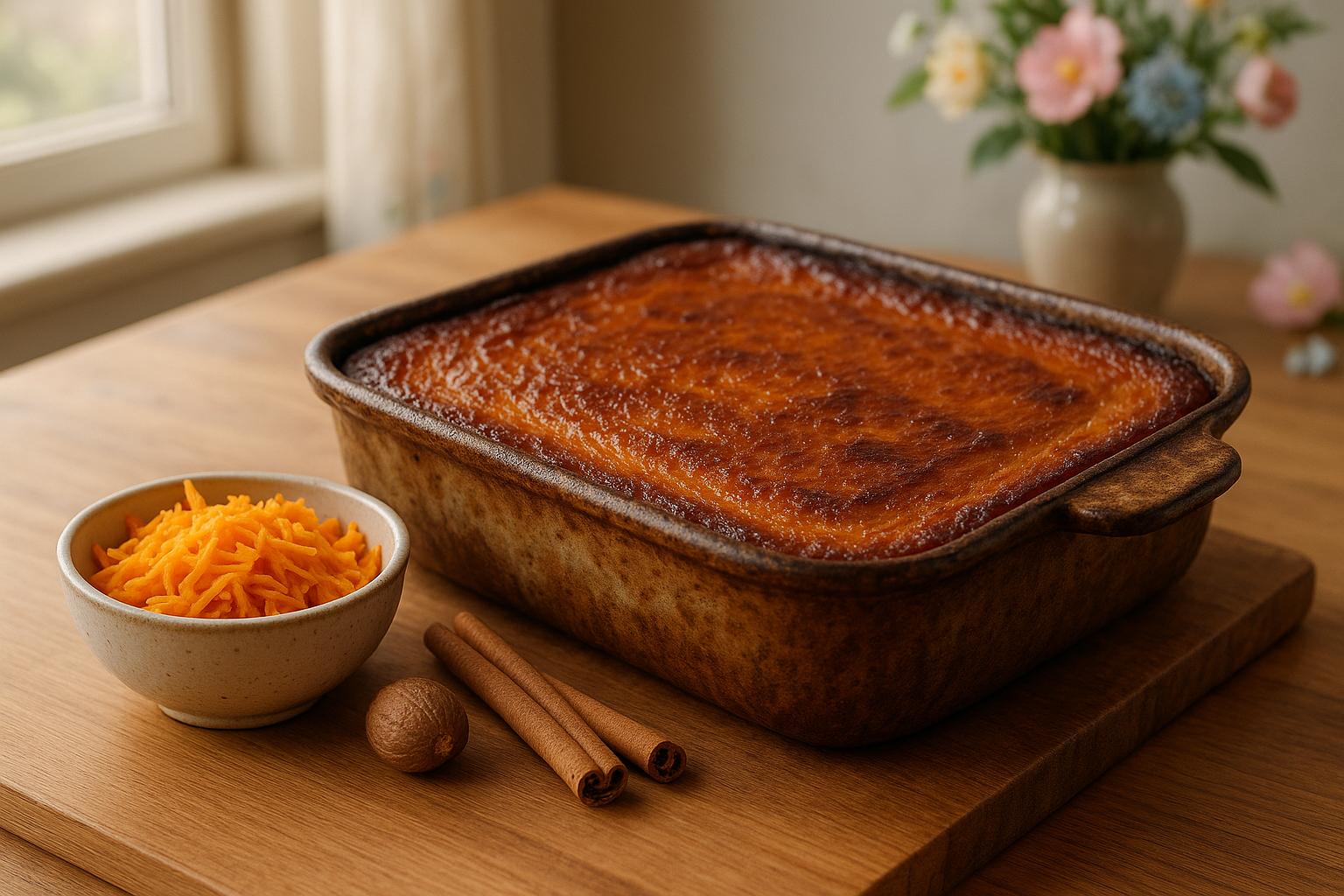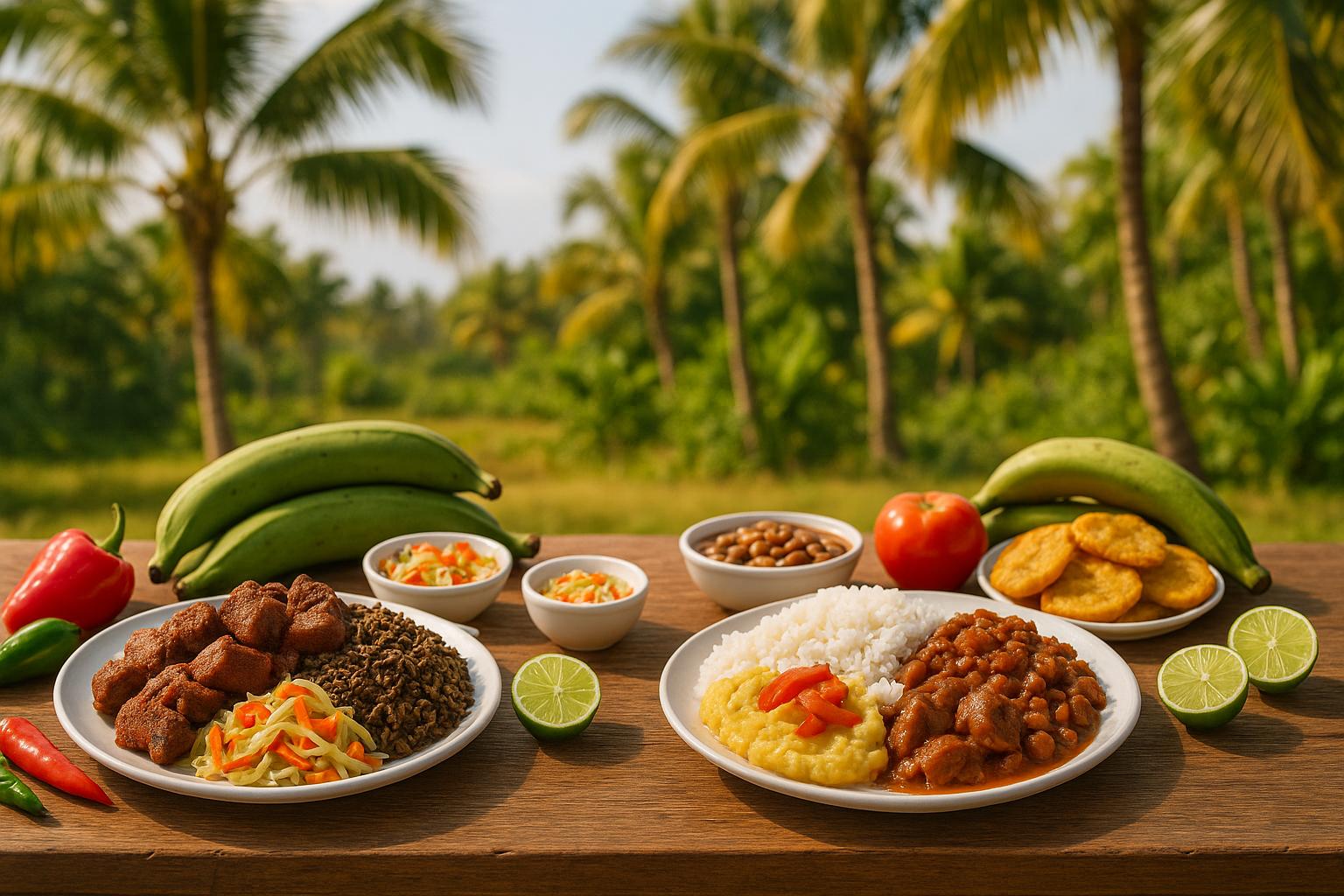Pate Kode is a beloved Haitian street food, known for its crispy dough and savory fillings. Often compared to empanadas, it features bold flavors like smoked herring, chicken, or hot dogs, paired with spices and vegetables. This snack is commonly enjoyed for breakfast, at gatherings, or as a nostalgic treat in Haitian households.
Key Steps:
- Dough Prep: Combine flour, salt, baking powder, and butter for a flaky texture. Add water gradually for elasticity.
- Fillings: Choose from options like smoked herring, chicken, or vegan alternatives. Season generously with garlic, onions, and peppers.
- Assembly: Place filling on dough, fold into a half-moon, and seal edges with a fork.
- Frying: Fry at 350–375°F until golden brown. Drain on paper towels to remove excess oil.
Pairings:
- Serve with Pikliz (spicy pickled veggies) or a fresh salad for balance.
- For dipping, try yogurt or chimichurri.
Storage Tips:
- Refrigerate cooked patties for 3 days or freeze for up to a month.
- Reheat in the oven at 325°F to maintain crispness.
This iconic dish connects people to Haitian roots while offering endless possibilities for fillings and flavors.
HOW TO MAKE THE BEST PATE KODE AKA HAITIAN PATTIES
Ingredients and Tools You'll Need
Pate Kode relies on ingredients you can easily find in U.S. grocery stores, with room for creativity in both the dough and fillings.
Dough Ingredients
The key to a great Pate Kode is a dough that can hold its shape during frying. While recipes may differ slightly, the basics are always the same.
Essential ingredients include all-purpose flour, water, salt, and oil. Some recipes also call for baking powder or baking soda to add texture. Here are two popular variations:
- Simple version: Combine 2 cups of flour, 1 teaspoon of baking powder, ½ teaspoon of salt, ½ cup + 2 tablespoons of cold water, and ½ teaspoon of bouillon base [3]. The bouillon adds a subtle savory kick.
- Rich version: Mix 3 cups of all-purpose flour, 1 teaspoon of salt, 1 teaspoon of baking powder, ½ teaspoon of baking soda, ¾ cup of cubed cold butter, ¼ cup of vegetable oil, ¼ cup of cold water, and ½ cup of warm water [5]. This creates a tender, flaky dough.
For a more indulgent dough, you can add butter or vegetable shortening. Using cold water will give you a crispier texture, while warm water makes mixing easier.
Once your dough is ready, it's time to think about the fillings.
Filling Options
Traditional fillings often feature smoked herring and eggs, seasoned with garlic, onions, chili, shallots, and herbs [2]. But modern versions have introduced more accessible proteins.
Popular combinations include hot dogs and eggs, chicken and cabbage, or seasoned ground beef [3][7]. Ground pork, turkey, and fish like cod are also excellent choices for variety [6]. Whatever you choose, make sure your protein is well-seasoned and fully cooked before assembling.
For those who enjoy spice, Scotch bonnet peppers are a classic option. You can swap these for habanero peppers or use less to tone down the heat [6]. If you prefer no heat at all, simply skip the peppers [8].
Take inspiration from places like La Paix Bakery in Miramar, Florida. As of December 2023, they offer a variety of Haitian patties with different fillings, available in-store or through delivery platforms like DoorDash and UberEats [2].
Vegetable additions such as diced onions, bell peppers, and cabbage can enhance both texture and nutrition. Many families tweak their fillings to suit their tastes and dietary preferences [3].
Kitchen Tools
You'll need some basic tools to get started, and most kitchens already have what’s necessary.
Grab mixing bowls, a rolling pin, and a knife or cookie cutter to shape the dough. Use a fork to seal the edges, which helps keep the filling from spilling out during frying.
For frying, you can use a deep frying pan with enough oil to submerge the patties or a deep fryer if you have one. Maintaining a consistent oil temperature is crucial for even cooking.
When preparing the dough, you can mix by hand or use a food processor. Hand mixing is often preferred, especially for beginners, as it gives you better control over the dough’s texture [4].
After frying, place the Pate Kode on paper towels to drain excess oil [5]. This step helps improve the final texture and reduces greasiness.
Optional tools that can make the process smoother include a pastry brush for applying egg wash, measuring cups for accuracy, and a thermometer to monitor oil temperature. These extras are especially useful for larger batches or if you’re aiming for a polished result.
How to Make Pate Kode
Crafting Pate Kode involves three key steps: preparing the dough, creating the filling, and assembling the patties for frying. Each part is essential to achieving that perfect balance of crispiness and savory flavor.
Making the Dough
Begin by mixing your dry ingredients in a large bowl. Combine 3 cups of all-purpose flour, 1 teaspoon of salt, 1 teaspoon of baking powder, and ½ teaspoon of baking soda until they're well blended.
Next, add ¾ cup of cold, cubed butter and ¼ cup of vegetable oil to the dry mix. Use a pastry cutter or your fingers to cut the butter into the flour until the mixture resembles coarse crumbs. This step is crucial for creating a flaky texture.
Slowly incorporate the water. Start with ¼ cup of cold water, then gradually add up to ½ cup of warm water while kneading. Knead the dough until it’s smooth, elastic, and just moist enough to avoid sticking. Getting the consistency right is key for a dough that rolls out easily and fries beautifully.
"I practiced making this so much and I'm very confident that my dough recipe is foolproof if you follow my instructions carefully!!" - Manie Chery
Divide the dough into 8–12 portions and roll each piece into a thin disc. Thinner discs will give you crispier patties, while slightly thicker ones provide a chewier bite.
Preparing the Fillings
The filling options for Pate Kode are versatile, but the preparation process remains fairly similar across variations.
- Hot Dogs and Eggs: Sauté diced hot dogs with epis (a Haitian seasoning base), onions, and hot pepper. Remove from heat and mix in diced hard-boiled eggs. Season the mixture with garlic powder, onion powder, dried thyme, and black pepper.
- Chicken, Cabbage, and Eggs: Marinate chicken thighs with lime juice, clove, and epis. Boil the chicken and reserve some of the cooking liquid for later. Shred the cooked chicken and sauté it with onions and hot pepper. Add dry seasonings, shredded cabbage, and a bit of the reserved liquid. Cook until the cabbage softens slightly, then fold in diced eggs.
- Vegan Option: Heat vegetable oil in a skillet and sauté minced garlic, chopped bell peppers, and green onions until softened. Add shredded cabbage, cajun seasoning, kosher salt, fresh parsley, and a splash of water. Cook until the vegetables are tender.
- Smoked Herring: Start by soaking salted smoked herring in cold water to remove excess salt. Drain and flake the fish, then fry it in hot oil. Add chopped onions, shallots, bell peppers, piment bouc (a type of hot pepper), black peppercorns, and garlic. Cook until the onions turn translucent.
Assembly and Frying
Place a portion of your chosen filling in the center of each dough disc. Be careful not to overfill, as this can make sealing difficult and lead to leaks during frying.
Fold the dough over the filling to form a half-moon shape. Press the edges firmly or use a fork to crimp them, ensuring the filling stays secure. Pierce the top of the dough a few times with a fork to allow steam to escape while frying.
Heat oil in a frying pan to 350°F to 375°F. The oil should be deep enough to partially submerge the patties. Gently place the patties into the hot oil and fry over medium-high heat. Cook each side for 3–4 minutes, or until both sides are golden brown.
Once cooked, transfer the patties to a plate lined with paper towels to absorb any excess oil. This step ensures they stay crispy without being overly greasy.
Let the patties cool slightly before serving. This allows the flavors to settle and ensures you enjoy that perfect crunch with every bite.
sbb-itb-80c33ff
Serving and Recipe Variations
What to Serve with Pate Kode
Pair your Pate Kode with Pikliz, a spicy pickled vegetable relish that perfectly balances the richness of these fried patties. The tangy heat of Pikliz adds a vibrant kick to every bite.
For a refreshing contrast, serve alongside a crisp salad made with lettuce, tomatoes, and cucumber. The cool crunch of fresh veggies not only complements the warm, hearty patties but also adds a touch of nutrition to the meal. It's a great way to cleanse your palate between bites.
Looking for dipping options? Try adding plain Greek yogurt or chimichurri sauce to the table. These suggestions, highlighted by Kids Eat in Color in June 2022, bring a new dimension of flavor. Pairing Pate Kode with seasonal fruits or vegetables also creates a balanced and satisfying meal.
Whether you're making these patties the star of a lunch spread or serving them as appetizers, these accompaniments honor the dish's Haitian origins while offering a well-rounded dining experience.
Recipe Modifications
While the traditional recipe remains a beloved street food classic, it's easy to tweak Pate Kode to meet different dietary preferences, making it a versatile option for modern kitchens.
For vegetarian or vegan versions, swap out the meat for plant-based proteins. Options like kidney beans, black beans, chickpeas, or pigeon peas work wonderfully as substitutes. You can also craft flavorful fillings with mushrooms, corn, or a medley of vegetables. Adding tomato paste to these mixtures enhances the depth of flavor.
"This is a vegan recipe for pate kode. However, for those of you who are not vegan and want the option to jazz it up with your favorite meat options, here are some suggestions that can go in your delicious pate." - Savory Thoughts
Another creative option is using plant-based ground crumbles as a meat alternative. Combine these with an egg replacer and a bit of coconut oil to help bind the pastry dough. Adding a splash of water to the filling ensures it stays moist during cooking. For the dough, choose a vegan-friendly recipe designed for frying.
For a gluten-free take, simply replace the all-purpose flour with a gluten-free flour blend. While the preparation method stays the same, you might need to tweak the liquid measurements slightly to account for the flour's texture.
Once you've tailored the recipe to your needs, it's important to know how to store and reheat your patties to keep them tasting fresh.
Storage and Reheating Tips
To keep your Pate Kode fresh and crispy, proper storage and reheating are key.
For short-term storage, place the cooked patties in an airtight container and refrigerate for up to 3 days. If you'd like to store them longer, freeze the cooked patties in a flat, airtight bag for up to 1 month. Uncooked patties can be frozen for up to 3 months - just thaw them in the refrigerator before frying.
Reheating is best done in the oven to maintain that golden, crispy crust. For refrigerated patties, reheat at 325°F for 10-15 minutes. If frozen, extend the time to 20-25 minutes. This method ensures the texture stays intact, unlike microwaving, which can leave the pastry soggy.
History and More Resources
History of Pate Kode
Pate Kode, Haiti’s beloved fritay take on a deep-fried empanada, has been bringing people together for generations [10].
This dish is a testament to Haiti's rich culinary heritage, blending African, French, and indigenous Taíno influences. Over time, it has become more than just a meal - it’s a symbol of connection, often shared during family gatherings, celebrations, and holidays [9].
Traditionally filled with spicy smoked herring [2], Pate Kode has grown to include a variety of fillings, giving customers the freedom to choose their favorite flavors [1]. Across Haiti, each region has added its own twist, creating unique versions that highlight the diversity of Haitian cuisine [9]. Despite its simplicity, this street food is cherished as a cultural treasure, described by some as “nothing fancy, something prepared by the hand of a hard-working person” [11]. It’s a humble yet powerful reminder of Haiti’s culinary and communal spirit.
This is just one chapter in the vibrant story of Haitian food, with so much more waiting to be discovered.
Find More Recipes on HaitianFoods.org

If Pate Kode has sparked your interest, HaitianFoods.org is the perfect place to dive deeper into the world of Haitian cuisine. This site is a treasure trove of authentic recipes, restaurant listings, and cultural insights, offering a comprehensive guide to Haiti’s culinary traditions.
From street food classics to festive holiday dishes, HaitianFoods.org provides step-by-step recipes and detailed cultural context to help you bring these flavors to life in your own kitchen. Whether you’re perfecting your Pate Kode technique or exploring new dishes, this resource has everything you need to expand your skills.
For food enthusiasts looking to experience Haitian cuisine firsthand, the platform also features a global directory of Haitian-owned restaurants. Restaurant owners can even submit their businesses to the site, connecting with a wider audience and supporting the growth of Haitian culinary traditions worldwide.
Ready to explore more? Visit HaitianFoods.org to find your next favorite recipe or locate authentic Haitian restaurants near you.
FAQs
What should I avoid when making the dough for Pate Kode?
When preparing the dough for Pate Kode, there are a few things to watch out for to ensure the best results. Using too much water can leave the dough sticky and difficult to handle, while too little water can lead to a dry, crumbly consistency. Another key tip: avoid overworking the dough, as this can make it tough and take away from its flakiness. When rolling it out, aim for just the right thickness - too thick, and it may not cook evenly; too thin, and it could tear when you add the filling. Paying attention to these steps will set you up for a perfectly made Haitian treat!
Can I make Pate Kode in an air fryer for a healthier option?
Yes, you can definitely make Pate Kode in an air fryer as a lighter option compared to deep frying, since it uses much less oil. Just note that the texture might turn out a bit different, especially if the dough is on the thicker side or packed with a lot of filling. To get that golden, crispy finish, try brushing the Pate Kode lightly with oil before popping them into the air fryer.
How can I adjust Pate Kode fillings for different dietary needs?
To make Pate Kode fillings work for different dietary needs, you can tweak the ingredients to fit various preferences or restrictions. For a vegan twist, go with plant-based options like sautéed veggies or seasoned tofu. Dealing with gluten intolerance? Use a gluten-free crust instead. If you're cutting back on sodium or avoiding allergens, choose low-sodium seasonings and skip ingredients like nuts or dairy.
Some popular filling ideas include cooked spinach, mushrooms, lean chicken, or a flavorful mix of beans and spices. With a bit of imagination, you can enjoy this Haitian classic while catering to everyone’s needs!


